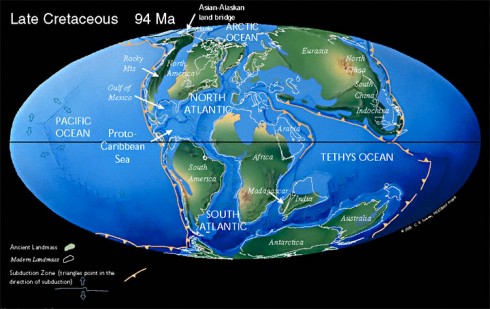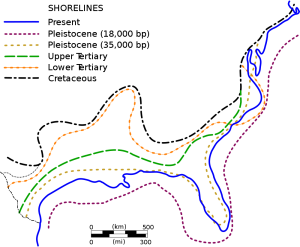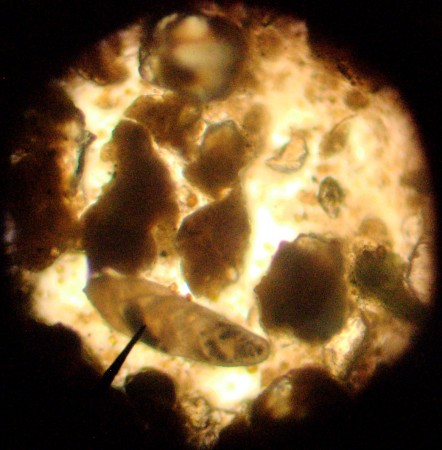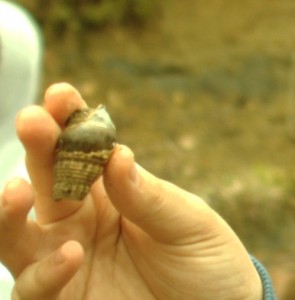
Collecting the amazingly well-preserved Cretaceous molluscs and arthropods at the Coon Creek Science Center was an excellent way to learn about fossils and the geology of the Mississippi Embayment.
Consider: the actual shell of an actual organism that actually lived 70 million years ago; not the form of the shell, petrified in silica; not the silent imprint of ridges and grooves in the mud of some bivalve’s test, long dissolved by the silent flux of millenia of groundwater flow, although you can find those, too; but to stand in the daylight, on the gravel bar of a creek, and hold the actual shell of an actual marine organism that lived here when it was six meters under water.
When we got to Coon Creek, Pat Broadbent did her typical, excellent presentation, starting with the very basics question of, “What are fossils?” Apart from the aforementioned actual preserved shells, you can also find trace fossils, like, for example, where the imprints of the an organism is left in the mud while the shell itself has long dissolved away. They can be imprints, or molds of the shells. One of my students found the mold of a crab’s claw along the creek bed; the mud filling in the claw had solidified into rock but you could clearly see where the pincer once articulated.
Pat also talked about the Mississippi Embayment, which is the long, broad valley through which the Mississippi River flows.

When the supercontinent Pangea started to break up, North America pulled away from Europe and Africa. This created a rift that eventually became the North Atlantic Ocean. At about the same time, North America tried to split into two as a second rift was created, right where the Mississippi Embayment is today.

But the rift failed (Cox and Van Arsdale, 2007). It did, however, stretch and thin the continental crust enough to create a large inland sea running up the middle of North America. Over the 100 million years since, the rift formed, the Mississippi Embayment has filled in, first with oceanic sediment, but then with terrestrial sands and silts as the mountains to the east and west were eroded away and washed into the inland sea.
The layer of silt and glauconite clay that encases the fossils at Coon Creek is called the Coon Creek Formation. Pat was very clear that we should refer to this material surrounding the fossils as “matrix”. The “d” word was prohibited. These sediments were deposited while the sea still flooded the embayment. They formed a sand bank, several kilometers offshore.
I vaguely remember doing some research on glauconite a long time ago. Glauconite pellets are found in shallow marine waters, usually far enough away from the coastline so that sediment is deposited slowly, and it’s the finer materials, such as silts and clays, that are deposited. The water also needs to be deep enough to protect the fine sediment from the force of the waves. These are ideal conditions for clams, mussels, conchs, and their Cretaceous relatives.
A simple smear of the sediment across a microscope slide is enough to show that the matrix is has a lot of quartz. You need a microscope because the mineral grains are tiny, silt sized or smaller.
But the best part of looking at the slides is finding the microscopic fossils. They’re not as ubiquitous as you might think, but they’re there if you look. I found a couple of forams, a snail-like one and another that looks like a bolivina species.

However, the smear slides came later. After Pat’s talk, she took us out to a small mound of matrix that had been excavated for sampling. Everyone grabbed chunks of matrix and pared away at them until they found something promising. These promising samples were wrapped in aluminum foil so we could clean them up under more controlled conditions.

Cleaning takes time and patience, so Pat showed us how to do it, and each student worked on a single sample. The main idea is to create a display of the fossil using the matrix as a base. The general procedure is to:
- Use a small pick, paintbrush and spray-bottle of water, to wash and wipe away the matrix from the fossil.
- Let it dry out well, which usually takes about five days.
- Paint the entire thing with a 50-50 mix of acrylic floor wax and water. Pat recommends Future Floor Wax, but that seems to have been rebranded out of existance.
- Repeat that last step three times (let it dry for about 15 minutes inbetween) to get a well preserved, robust sample.
After the instructions on cleaning, we broke for lunch. For most of us lunch could not have come early enough, not because we were particularly hungry, but because it was quite cold outside. Just the week before the temperature had been above 20 °C, t-shirt weather. Now students were clustering around a couple space heaters trying to ward off frostbite (or at least that’s what they claimed). I did offer that they could stay inside after lunch while the rest of the class walked along the creek, but no-one took me up on it. I don’t know if it’s specific to this group or just to adolescents in general, but if there a chance to walk through water, and get dirty and wet, they’ll take it no matter what the consequence.

Walking the creek, pulling shells and molds out of the gravel bars, was the best part of the visit.

The water was shallow, not getting up above the shins, despite the rain showers of the preceding days. A few students borrowed rubber boots, which half of them proceeded to fill with water.
There were quite a lot of fossils. Some of the bivalves have really thick strong shells that not only survived the 70 million years since the Cretaceous, but being washed out of the matrix and tumbled down a stream bed with all sorts of sand and gravel. Some of the casts, like the aforementioned arthropod claw, are also pretty robust.

A couple of the more interesting finds are the rather elongate tube like structures that are believed to be either fossilized burrows, or fish feces (coporolite). The material in the coporolite has been replaced by minerals, which is why it survived, but it still retains a little of the ick factor.
There’s an awful lot to learn at Coon Creek. I did not even mention the mesosaur skeletons that have been found there, but there is a nice IMAX movie, Sea Monsters, that’s a nice complement to the field trip because it’s set at the same time, and in the same marine environment as the Coon Creek Formation.